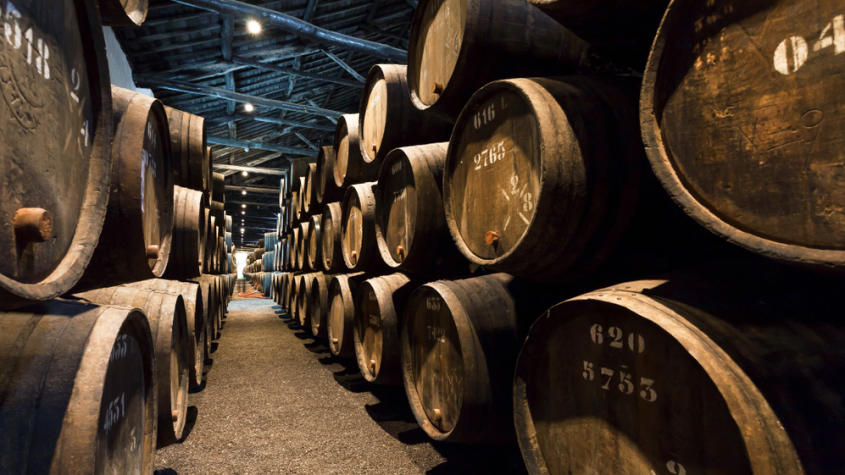Port: Discover this Portuguese fortified wine

Port is a fortified wine to which wine brandy is added. It is native to northern Portugal, in the Douro Valley. Port is produced from black grapes from the Touriga Nacional, Touriga Franca, Tinta Roriz, Tinta Cao and Tinta Barroca grape varieties. Port can also be made from white grapes.
What is the origin and history of port?
The history of Port dates back centuries of bravery and determination. In the 17th century, intrepid sailors sailed the Douro to the city of Porto, from which the wine takes its name. Winemakers discovered that adding a small dose of brandy to fermenting wine gave it a unique robustness and allowed it to survive long sea voyages.
These robust wines quickly gained popularity and attracted worldwide attention. Its rich flavors, sweetness and intense aromas have conquered the palates of intrepid wine lovers throughout the centuries. The spectacular terraces of the Douro, with their entwining vines, have become the birthplace of port, a true jewel of fortified wines.
Over time, different aging techniques have been developed to create a diverse range of ports. Ruby Ports , young and fruity, were born, while Tawny Ports , aged in oak barrels, acquired a captivating complexity with notes of dried fruit and spices. Vintage Ports , from the best vintages, are considered rare and precious treasures.
Today, port is a living heritage, a unique product to savor. From century-old cellars to legendary port houses, history is revealed in every sip, evoking the daring spirit of the navigators who braved the tumultuous waves to take port beyond the horizons.

How is port produced?
It all starts with the careful selection of the most robust and resilient grape varieties, grown on the steep slopes of the Douro. The harvest takes place by hand, in sometimes acrobatic conditions, in order to guarantee the maximum quality of the grapes.
Once harvested, the grapes are carefully transported to the cellars, where the magic happens. The crushed grapes give rise to a rich and sweet must, which ferments. This is where the secret of port lies: the addition of a grape brandy, also called brandy, to stop fermentation and leave some residual sugar. This alcoholic addition gives the wine its strength and power.
But the adventure doesn't stop there. The port wines are then transferred to large oak barrels, which rest in the dark, damp cellars. There, the wines develop their unique character over the years, through a complex process of controlled oxidation. Ruby ports retain their fiery youth, while Tawny ports, aged for a long time, acquire aromas of dried fruits and caramel.
These precious nectars are often assembled with care, mixing different vintages and vintages to create unique taste harmonies. Master blenders, like wine alchemists, ensure that each bottle of port embodies the spirit of the Douro wilds.
And finally, when the time is right, these dazzling beverages are bottled, ready for daring wine adventurers to enjoy

Ruby or tawny port?
Ruby Port is a type of fortified wine produced in the Douro Valley in northern Portugal. It is usually a blend of several grape varieties, including Touriga Nacional, Touriga Francesa, Tinta Cao, Tinta Barroca and Tinta Roriz. The wine is generally aged for 3 to 5 years in oak barrels before being bottled. Ruby Port is generally deep red and is sought after for its round and fruity character.
Tawny Port is another type of port produced in the same region of Portugal. Tawny Port is usually a blend of several different grape varieties, such as Ruby Port. The wine must age for a minimum of 5 years in oak barrels before being bottled. Tawny Port with an age indication on the label starts at 8 years and can go up to 50 years in general. They have a more tiled or even brick color depending on the age of the Port. They reveal flavors of nuts and caramel and can be drunk with desserts or alone at the end of a meal.
What are the different types of Port?
Vintage Ports
Those are the more emblematic , the king of port wines . They come from a single harvest exceptional And grapes _ _ first class (6 varieties in total ) and are accredited by the Douro Institute and of Wine from Porto. Put in bottle After two years And aged in bottle during Again two years . We can THE drink young but It would be better wait at least 10 years Before of THE taste because we knows that after more than a century we go to have A enough Good vintage . They born represent that 3% of there production total .
Late Bottled Vintage Ports
Also called “LBV”, they are also coming from a single harvest, they are produced with THE same grapes and In there even year that the “ Vintage” . But it is not quite at the level of quality required to deserve the Vintage mention and aging in barrels lasts longer, from 4 to 6 years. As a result, the wine is less powerful than a “Vintage” and its capacity for aging in the bottle does not reach that of a “Vintage”. It is also very pleasant to taste an LBV as soon as it is bottled.
Ruby Ports
This is a blend of wines from different years with an average of 3 to 5 years of aging in casks. The name "Ruby" designates common wines. For certain “houses” it is in fact the assembly of what remains when they have done the best. It is better to look at “Ruby Reserve” or “Finest Reserve” which designate more precise blends.
Tawny Ports
These are wines that have aged at least 5 years in 500 liter oak barrels. With contact with air and wood, these wines oxidize. They are classified according to their age. There is :
- “Tawny” (basic) which designate Port wines that have been aged for 5 to 6 years
- “Tawny Reserve” for Port wines that have aged 7 to 8 years
- The “Tawny with indication of age”, all these wines are the result of a blend of years. The goal of the winemaker preparing a new batch of “Tawny” is to replenish the flavors of the exhausted one. But the age of the wine is in fact the average age of the wines that compose it. So half 8 years old and half 12 years old would give a ten year old.
- “Tawny Colheita” which designate vintage Port wines (example: Colheita 1995). These are real “Tawny”, the original tawny which is used to blend aged Tawny.

How much alcohol is in port?
Port is a fortified wine or also called fortified wine, obtained by adding brandy to the wine during fermentation, which makes it a strong drink, which can contain a lot of alcohol. The alcohol content of port can vary, but is generally between 18% and 22% by volume, meaning it is on average 50% higher than most wines.
What are the recommended food and wine pairings with port?
Port is a sweet, fortified wine that offers a wide range of flavors and taste characteristics. Here are some food and wine pairing recommendations to accompany port:
-
Cheeses: Port goes very well with soft, creamy cheeses such as Brie or Camembert or also blue cheeses such as Roquefort or Gorgonzola. Older cheeses like cheddar or parmesan can also be good choices.
-
Chocolate: Port and chocolate are a classic pairing. Try pairing ruby port with intense dark chocolate or tawny port with milk chocolate or caramel desserts.
-
Dried Fruits: The dried fruit flavors of port pair well with almonds, walnuts, figs, dates and prunes. They can be served as a side dish or integrated into desserts.
-
Desserts: In addition to chocolate, port goes well with desserts based on red fruits, fruit tarts, crumbles and spiced desserts such as apple tart or spice tart.
How long can you keep a bottle of port?
The shelf life of a bottle of port depends on the type of port, vintage and storage conditions. In general, high quality Vintage Ports can be stored for several decades or more and will develop complex flavors and improve over time. Aged Ruby Ports can also be stored for many years thanks to their controlled oxidation process but they will not evolve in terms of aromatics.
However, it is important to note that most ports are not designed for extended aging and are intended to be enjoyed younger. Non-vintage Ruby Ports and Tawny Ports are generally ready to enjoy upon purchase and have no benefit in being allowed to age.
To ensure optimal conservation of port, it is recommended to store it in a cool, dark place without excessive temperature variation. A wine cellar or cellar are ideal places to preserve the qualities of port over time.
How is port wine drunk?
First of all, Port is tasted slowly, with a patience worthy of an explorer in search of hidden treasures. Take a sip and let the flavors blossom on your palate.
Then, don't hesitate to offer it an adequate serving temperature. For red Ports, a slight cooling between 12°C and 16°C will reveal their captivating aromas. Milder versions, such as Tawny Ports, are best enjoyed slightly chilled, between 10°C and 14°C.
As for glasses, opt for Port wine glasses or balloon glasses to better concentrate the scents. Tulip glasses are also perfect for capturing aromatic nuances.
If you're exploring Vintage Ports, don't forget to decant them. This will allow these exceptional wines to fully express themselves and release their taste treasures.
Finally, know that Port wine is a companion of choice for moments of conviviality and celebrations. It can be enjoyed as an aperitif or digestive, but also as an accompaniment to fruit desserts or mature cheeses.
Is port an aperitif?
Well, believe it or not, Port can be a real wonder as an aperitif! This divine nectar, fortified and refined, is an ideal companion to start your festivities with panache.
Imagine yourself, installed in the heart of a friendly lounge, surrounded by your adventure companions, a glass of Port in hand. The captivating aromas of nuts, dried fruits and candied fruits delicately tickle your nostrils, announcing a promising tasting experience.
Port, whether Tawny, Ruby or White, offers you a palette of complex and refined flavors. The drier versions, like Tawny or White, are perfect for awakening your taste buds before a meal.
But be careful, dear adventurer, Port is much more than a simple aperitif. It can also be enjoyed as a digestive, to end your feasts with a sweet and elegant note.
So, whether to open the festivities in style or to end in apotheosis, Porto is an undeniable ally for your moments of conviviality.



